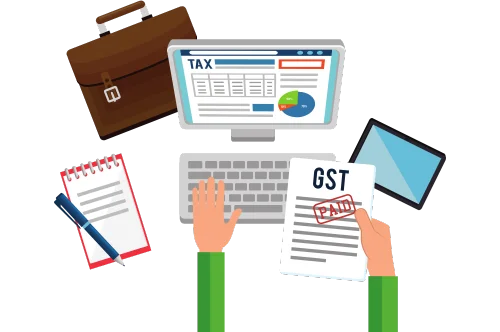Set-Off and Carry Forward of Losses: A Guide for Taxpayers
In the world of income tax, understanding how to manage losses effectively is just as important as maximizing gains. Set-off and carry forward provisions under the Income Tax Act help taxpayers mitigate their tax liability by adjusting losses against future or current income. This article aims to demystify these concepts and explain how you can make the most of them.
Also, while planning your taxes, don’t forget to link PAN with Aadhaar, as it is mandatory for filing income tax returns and claiming such benefits.
What is Set-Off of Losses?
Set-off of losses refers to the adjustment of losses incurred in one source of income against income from another source. For instance, if you’ve suffered a business loss but earned income through rent, you can use the loss to reduce your total taxable income.
There are two main types of set-off:
1. Intra-head Set-Off
This refers to setting off losses against income from the same head of income. For example:
-
A loss from one business can be adjusted against profits from another business.
-
Loss from one property can be set off against rental income from another property.
However, certain restrictions apply. For instance, losses from speculative business cannot be set off against non-speculative business income.
2. Inter-head Set-Off
When a taxpayer cannot fully utilize losses under the same head, they may adjust them against income from another head of income. For example:
-
Business losses can be set off against salary or house property income.
-
Loss from house property (up to ₹2 lakh) can be set off against any head of income.
However, capital losses cannot be adjusted against income from other heads.
Before claiming these benefits, ensure that you link PAN with Aadhaar. If not, your PAN may become inoperative, and you won’t be able to file your return.
What is Carry Forward of Losses?
Sometimes, losses may not be entirely adjusted in the same assessment year. In such cases, they can be carried forward to future years and set off against eligible income in subsequent years. This is known as carry forward of losses.
Types of Losses and Their Carry Forward Periods
| Type of Loss | Carry Forward Allowed | Set Off Against |
|---|---|---|
| House Property Loss | 8 years | Income from house property |
| Business Loss | 8 years | Business income only |
| Speculative Business Loss | 4 years | Speculative business income only |
| Capital Loss (Short-Term) | 8 years | Any capital gains |
| Capital Loss (Long-Term) | 8 years | Only long-term capital gains |
| Loss from Owning/Racing Horses | 4 years | Same activity |
To carry forward losses, filing the income tax return before the due date is crucial. And to do that, one must link PAN with Aadhaar as mandated by the Income Tax Department.
Conditions to Claim Set-Off and Carry Forward
There are certain key conditions that a taxpayer must meet to avail of these benefits:
-
Timely Filing of ITR: Losses must be declared in a valid return filed before the due date under Section 139(1), except for house property loss which can be carried forward even if the return is belated.
-
Maintain Records: Adequate documentation of losses is essential. The tax department may ask for proof.
-
Link PAN with Aadhaar: As per Section 139AA, taxpayers must link PAN with Aadhaar to make their PAN operative. Without this linkage, the PAN becomes inoperative, and ITR cannot be processed.
Practical Example
Let’s consider an example to make this clearer:
Mr. Rajesh incurred a short-term capital loss of ₹1.5 lakh and earned business income of ₹2 lakh in FY 2024–25. He also faced a house property loss of ₹1 lakh.
-
He can set off ₹1 lakh house property loss against business income.
-
The short-term capital loss of ₹1.5 lakh cannot be adjusted against business income. It will be carried forward for the next 8 years and can be set off only against capital gains.
Had Rajesh not filed his return on time or failed to link PAN with Aadhaar, he would lose the right to carry forward this capital loss.
Why It’s Crucial to Link PAN with Aadhaar
The Income Tax Department has made it mandatory to link PAN with Aadhaar to maintain consistency and transparency in tax records. If you don’t link them:
-
Your PAN becomes inoperative.
-
You won’t be able to file returns.
-
Refunds will not be processed.
-
You will not be able to carry forward losses to future years.
-
You may be liable to pay penalties and interest.
Hence, before you plan to set off or carry forward losses, ensure you link PAN with Aadhaar.
Steps to Link PAN with Aadhaar
Follow these simple steps to complete the process:
-
Visit the official Income Tax e-filing website.
-
Click on the ‘Link Aadhaar’ option.
-
Enter your PAN and Aadhaar number.
-
Enter the name as per Aadhaar and verify with OTP.
-
Submit the request.
Once done, check the status periodically. A pending status can be due to mismatched details.
If you face issues in filing your return due to a non-functional PAN, first link PAN with Aadhaar to regain access to income tax services.
Conclusion
Set-off and carry forward of losses are essential tax relief tools that allow taxpayers to manage their tax liability efficiently. Whether you’re an individual investor or a business owner, understanding these provisions can lead to significant tax savings.
But don’t forget, you cannot take advantage of these benefits if you don’t link PAN with Aadhaar. It is a mandatory compliance step that impacts your ability to file returns, claim refunds, and carry forward losses.
Our GST Services

All E-commerce Tax services
E-commerce tax services help online sellers navigate GST registration, compliance, return filing, TCS management, tax planning, and audits, ensuring efficient tax management and legal compliance.

GST Filing
GST filing is the process of submitting tax returns to the government, detailing sales, purchases, and taxes paid or collected, ensuring compliance with GST laws.

GST Registration
GST registration is the process where businesses obtain a GSTIN from the government, allowing them to collect taxes, claim input tax credits, and comply with GST laws.





